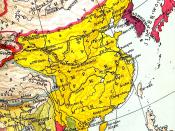Asian Studies 101
Term paper
Topic
Drawing on the downloaded articles on the 17th century silver crisis as well as the lectures and Murphey's A History of Asia, discuss the impact on China, Japan, Southeast Asia, and India of their integration into the global economy before 1800.
Name: Sifan Zeng
Student number: 39684097
Date: 08/03/10
In order to effectively analyze a phenomenon in the human science discipline we must consider the extended dimensions and relativities of one factor to another. The rise and fall one society is closely related to the activities others society. The significance of these relationships were evident in Asia in the 17th century, as we can use the silver crisis as an example to analyze the relations of natural disasters, political instabilities, external influences, social unrest and economical problem of one civilization to another in Asia at the time and how those event have affected the trends of the future before the 1800.
History uncovers itself through series of cause and effect events between century and century . The turbulences at a moment in history often pave the road for a harmonious period to come. From the 16th century onward a slow but surely shift in power from the East to the West took place, as each hundred years pass by this shift in power and influence was more obvious. By the end of the18th century European's trade intensive expansion have deeply embedded in all parts of Asia, some areas more than others. The key to the European's successes was often credited toward the industrial revolution, but even before the industrial revolution the European had a fundamentally different principle in economic development to the power houses of Asia. Most of China and India's wealth were generated domestically while the Europeans saw wealth in trade which later...


